xXxAlisha91xXx
spending too much on rocks
 
Member since February 2012
Posts: 284
|
Post by xXxAlisha91xXx on Apr 16, 2012 15:18:41 GMT -5
Awesome. I have a really crummy camera, but I tried to get a few decent pictures when the rechargeable batteries in it died. I can't find my other batteries, but here are the shots I got of one of them (I have a full medium flat rate box of this stuff, so I'm having trouble picking the ones that are preserved the best) : Specimen A  Here is one end of it:  Here is the other end of it:  I'm not sure if you can tell much from this one. Perhaps I should polish it up and try again? I have some really great opalized wood from VV, too. Most of the larger ones are the common variety, but I have some smaller precious ones too if y'all want to see it. I got them from the same guy. His website is here, if anyone else is interested in this pretty stuff: www.virginvalleyopal.com/ The opalized ones I have aren't top knotch to be able to ID, but they are still neat looking  |
|
sticksinstones
starting to spend too much on rocks
 
Member since February 2012
Posts: 117
|
Post by sticksinstones on Apr 16, 2012 22:42:29 GMT -5
The best shot at identifying it is actually the last pic with the fresher break. The weathered surfaces can sometimes give up a clue, but not in this case. Do you have the ability to polish the ends, like on a Diamond Genie or something? You can polish the end of a limb much as you would a cab and make a really neat (and revealing) specimen. I'd likely be able to tell more then. The camera looks like it'll do, just get the biggest (full size) and closest shot you can of the end grain once polished and I'll tell you what I'm able to extract from that.
|
|
xXxAlisha91xXx
spending too much on rocks
 
Member since February 2012
Posts: 284
|
Post by xXxAlisha91xXx on Apr 17, 2012 0:21:15 GMT -5
Yeah, I cab with a dremel, so I'll give it a try and post updated pics after that. Thanks  |
|
|
|
Post by johnjsgems on Apr 17, 2012 11:14:49 GMT -5
Great photos and information. I was going to ask the same magnification question. Helen, if a whole forest was somehow covered with the same silica rich mud you would expect the mineral replacement process to result in same colors for all species. The minerals that replace determine colors. I've collected a lot of mostly black wood in Utah that is same species as the more colorful "rainbow wood" from AZ.
|
|
sticksinstones
starting to spend too much on rocks
 
Member since February 2012
Posts: 117
|
Post by sticksinstones on Apr 17, 2012 15:40:53 GMT -5
Even thundereggs and agates that formed in the same silica rich environment can vary a great deal - sometimes even when they are touching in situ. Most petrified forests cover a few square miles and in some cases several hundred square miles, so you can see a fair bit of variation even within a single event forest which provides ample opportunity for their to be different trace minerals to add color to the silica as water filters the local minerals above the log - but they do tend to run consistent enough to identify them fairly easily in many cases even if you only have a slab and no original location information.
|
|
xXxAlisha91xXx
spending too much on rocks
 
Member since February 2012
Posts: 284
|
Post by xXxAlisha91xXx on Apr 19, 2012 0:13:16 GMT -5
Okay, I took a different piece and did a little bit of sanding on one end of it. It has a some opal on it, but it's not a complete cast, nor is it precious. In the pictures, it's still wet from sanding, so it's not a true representation of the color. I had to resize it because I'm on dial up and it takes forever to load the full size. Let me know if I need to load the full size or finish sanding and polishing the end. Here are the pictures: Specimen B This first picture is way off in color. Not sure why my camera did that...     |
|
|
|
Post by helens on Apr 20, 2012 15:22:25 GMT -5
Oops... Thanks stickinstones and John!!! I did not see the replies earlier!!! Makes a LOT of sense.
So technically, a hole underground can be filled with just about anything. IF that hole was a result of a piece of wood, then the outside would have the wood caste, and whatever the inside was left of the wood would also have a wood caste. If it was just a hole created by earth shifting, then it would fill in a weird shape/pattern that would be a 'rock'. In the case of a crack, it would become a 'seam', which is where we get the 'seams' of agates or whatever from.
From what John said, the filling material determines colors. So if say a part of a forest were overflown with lava, and all the trees in that section were preserved, then after millenia, compression would yield pieces in that same area, some of which are pet wood, and some of which are just rocks (because they are just holes filled with the magma).
Where it flowed over moss, you'd get dendrites embedded in the rocks, and where it flowed over animals, you'd get dino bone. All containing the same materials, in roughly the same colors, the variety being the textures and embeds. This only applies if the volcanic event occurred at the same time, in the same geological patch. Right?
I think I'm on the right page with that now... thanks!!!
Cool Pix Alisha!!!
|
|
Minnesota Daniel
freely admits to licking rocks
   A COUPLE LAKERS
A COUPLE LAKERS
Member since August 2011
Posts: 891
|
Post by Minnesota Daniel on Apr 20, 2012 19:06:46 GMT -5
Lava burns up everything in it's path. Trees and things could get buried in ash though. Or volcanic mudslides. After that that they could get covered over with lava I suppose.
|
|
|
|
Post by helens on Apr 20, 2012 21:25:47 GMT -5
Oh, that's right Daniel. So ash and mudslides massively compressed?
|
|
cardiobill
freely admits to licking rocks
  
Member since March 2012
Posts: 881
|
Post by cardiobill on Apr 20, 2012 21:35:05 GMT -5
Great information. I learn something every time I visit this board. Thanks for sharing
|
|
Deleted
Deleted Member
Member since January 1970
Posts: 0
|
Post by Deleted on Apr 21, 2012 0:48:20 GMT -5
Awesome post. I hope ya'll keep it up. Very informative and great photos.
I find a lot of dark agate and the pet wood here is the same color except for a few pieces with white and light brown.
Helen When I send your box I will send some wood from here if you are interested.
Jim
|
|
sticksinstones
starting to spend too much on rocks
 
Member since February 2012
Posts: 117
|
Post by sticksinstones on Apr 22, 2012 10:20:11 GMT -5
The cavities aren't actually filled with magma. Magma is usually basalt or other molten rock. It's more likely that the silica is carried to the cavity in suspension in ground water. Imagine if you didn't change that water filter in your kitchen for, oh... say, a couple of million years. The minerals in that water would completely replace that filter and leave you with a rock. If the mineral is mostly silica it has the highly desirable property of doing so on such a minute scale that actually preserves the shape of the original filter, right down to the fiber mesh. Of course absolutely pure silica isn't going to be in the water, a few other trace minerals will be present which help provide the nice color you want.
|
|
sticksinstones
starting to spend too much on rocks
 
Member since February 2012
Posts: 117
|
Post by sticksinstones on Apr 22, 2012 10:24:01 GMT -5
Okay, I took a different piece and did a little bit of sanding on one end of it. It has a some opal on it, but it's not a complete cast, nor is it precious. In the pictures, it's still wet from sanding, so it's not a true representation of the color. I had to resize it because I'm on dial up and it takes forever to load the full size. Let me know if I need to load the full size or finish sanding and polishing the end. Here are the pictures: Specimen B This first picture is way off in color. Not sure why my camera did that...  This last photo is the most useful in starting to get to an ID Alisha, but it's still not quite good enough. Can you polish the end of that piece further? If you get it to where it's actually smooth and shiny you'll be able to extract the details you need. This one you can start to see the fine rays and apparently tight growth rings in a neat little limb that will almost certainly reveal its secrets when polished. My guess at this point is that it's a fine grain hardwood (think of things like maple or fruit trees) but that is a complete SWAG at this point. We need to see the next level of detail to really say much. And if there's anything you can do to keep the photos are their original resolution (i.e. bigger) it helps too. |
|
Deleted
Deleted Member
Member since January 1970
Posts: 0
|
Post by Deleted on Apr 22, 2012 11:01:02 GMT -5
I have read all of this post and some of it twice and there is one thing that I am confused about. I find agatized wood and non agatized wood. With the non is it a case of not enough ground water flowing through or did it happen like a million years later than the agatized. I have also found a place where there are logs becoming exposed that just fall apart. I am assuming that in this case the logs were not buried deep enough to prevent oxygen from getting to it and it rotted but by this time there was not sufficient ground water to carry away the rotted material. I sold this piece so I am not able to get any close up photos of this piece of wood but it is the best wood that I have found. Most of the rocks around here are river wash so most are small from being tumbled and broken. 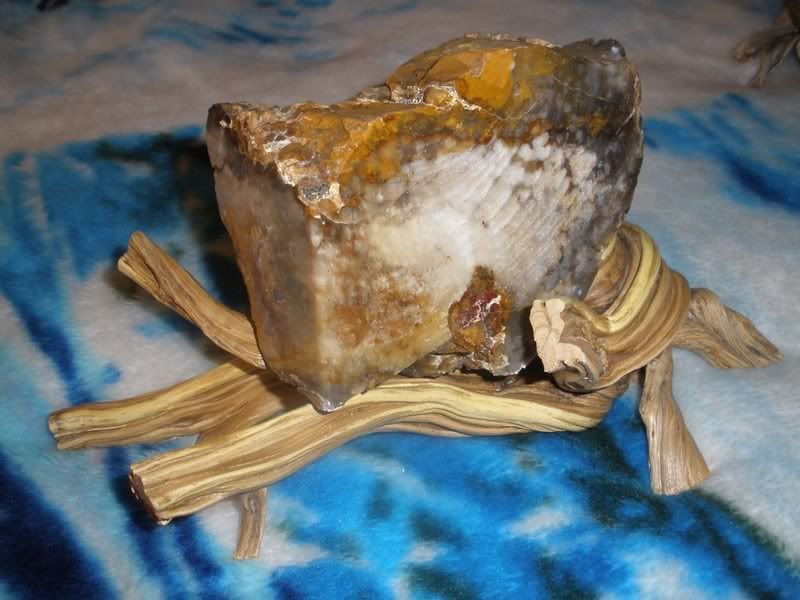 Jim |
|
sticksinstones
starting to spend too much on rocks
 
Member since February 2012
Posts: 117
|
Post by sticksinstones on Apr 23, 2012 18:50:46 GMT -5
Regarding non-silicified logs in the same general area as silicified logs. That's a good question. Usually I don't find the two in the same area - I'm either finding stuff like barite preserved logs or silica preserved logs, but not both in the same layer. Geology has a way of doing virtually everything at least once though so imagine some complex interaction of events and you'll probably be able to piece it together.
As for logs that are only imperfectly fossilized, you might be finding pieces near the surface that have weathered and decayed to be nearly gravel or sand already. Dig the same log deeper into the ground and you will often be able to follow the crumbly trail to a more complete log (this is how I typically find the stuff worth cutting). If you find something on the surface, there is a 90%+ chance that there is more/bigger/better buried somewhere nearby (depending on the nature of your deposit - alluvial deposits like the ones you described being an obvious exception).
Some logs never do petrify fully and they are this sort of fibrous mineral that seems like it's still half rotten wood. I've found a few like that in a road cut in NE Oregon. There's a guy at Western Washington U. that is focusing on logs like this in his research to try to help explain how logs petrify. Fascinating stuff that still isn't fully understood.
|
|
panamark
fully equipped rock polisher
  
Member since September 2012
Posts: 1,343
|
Post by panamark on Nov 25, 2012 11:22:54 GMT -5
I know this is an old thread, but Steve (Sticks&Stones) is there any chance you can repost pics that are now missing? I know you said they were on your own web site in a temp/scratch area and might get zapped, but this is a great writeup. If you want, email me the pics and I will permanently post them.
And can the admin then please pin this to the top of this forum list? I think it is EXCELLENT reference material. Thanks so much for your writeups Sticks&Stones. You have a very interesting web site, and a link in your sig line would be good for you.
Thanks again, Mark
|
|
Fossilman
Cave Dweller 
Member since January 2009
Posts: 20,718 
|
Post by Fossilman on Nov 25, 2012 16:51:39 GMT -5
Stickinstones.................Sounds like you live up river from where I hunt petwood and agates(Willametter River)in Independence,Oregon...(Can you ID these pieces?) I kind of like petwood as much as Montana agate and fossils... Here is one I found in the Willamette River in Independence,Oregon.....Wet,it looks as is,petwood,but dry,it looks like an ordinary rock.....I like it though..The rings are sharp looking. 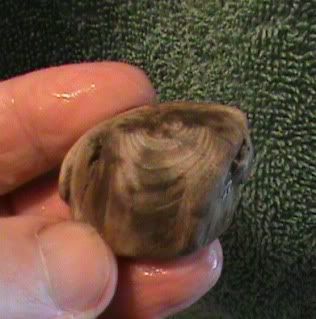  I call this petwood,my ugly duckling......Center is agatized with dark brown and black colors...Oregon found... 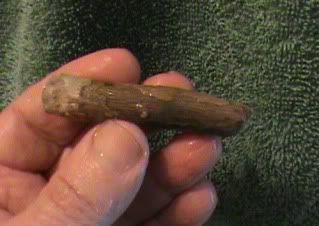 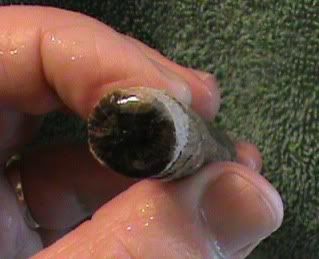 My most prized petwood is from eastern Oregon...Its a beautiful limb with agitized colors inside... 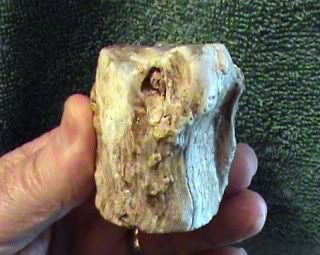  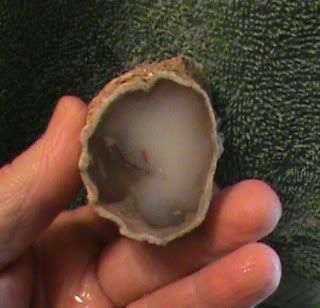 |
|
Deleted
Deleted Member
Member since January 1970
Posts: 0
|
Post by Deleted on Nov 25, 2012 17:59:25 GMT -5
Wow, that last piece is gorgeous!
|
|
Deleted
Deleted Member
Member since January 1970
Posts: 0
|
Post by Deleted on Nov 30, 2012 19:11:48 GMT -5
sticksandstones, you are amazing! Thank you for the knowledge. May I ask you to help with a one I found?    I picked it up in the Mojave Desert thinking it was petrified wood or at least a limb cast. When I cot the end off Ilearned it was very soft and had these fractures running thru it. Any idea what I have??
|
|